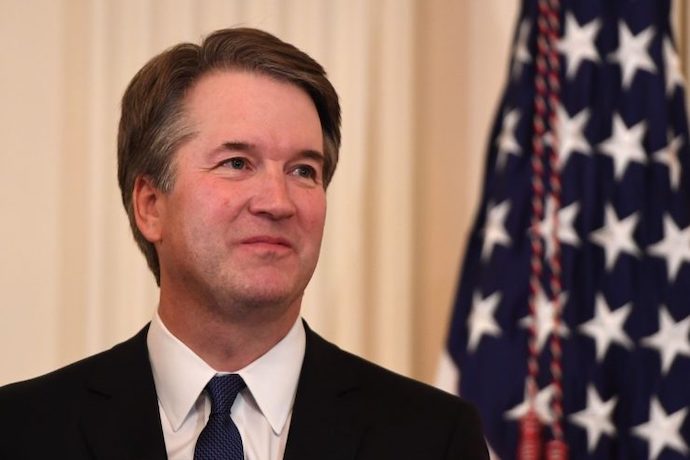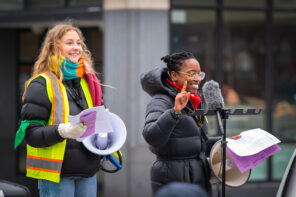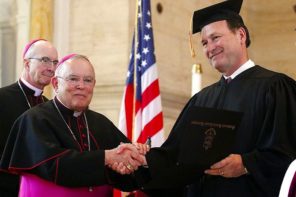If Brett Kavanaugh is confirmed to the U.S. Supreme Court (and do not doubt that he will be), the country’s highest court will remain, as it has been for over a decade, a majority Catholic institution. It will also mean that, depending on how we count Neil Gorsuch (more on that in a second), there hasn’t been a single Protestant on the Court since the retirement of Justice John Paul Stevens in 2010. Every justice has been and will continue to be either Catholic or Jewish.
Historically, this is a huge shift. Only 5 Catholics had ever served on the Court before Antonin Scalia’s appointment in 1986. Similarly, before Ruth Bader Ginsburg was appointed in 1993 there had been only 5 Jewish justices. One-hundred-and-thirteen people have sat on the Supreme Court; Scalia was the 103rd. And while this might appear to be a story about the arrival of Catholics into the mainstream of American life, it’s really the story of the religious right’s journey to dominance in U.S. politics through a powerful kind of coalition building. In other words, the Court, without a single Protestant on its bench, is the greatest triumph of a theocratically-minded American evangelical Protestantism.
A number of theories have been advanced to explain the Catholic and Jewish ascendency on the Supreme Court. Many of them point to the ways in which both Judaism and Catholicism have traditions of legal inquiry and the importance of higher education in Jewish and Catholic communities in the United States. What these theories miss, however, is how starkly the Catholic justices differ ideologically from the majority of American Catholics. If Kavanaugh is confirmed, five of the Court’s six Catholic justices will be reliable conservative votes, with Sonia Sotomayor as the sole exception. But polls indicate U.S. Catholics on the whole are a fairly progressive group. According to a recent Pew Survey, for example, 53 percent of U.S. Catholics support legal abortion and 67 percent favor marriage equality.
This phenomenon cannot be merely explained by the country’s general shift to the right over the past thirty years; it’s about a key factor in that rightward shift. The rightward movement of American politics up to and including the election of Donald Trump has been driven by a specific demographic, a demographic defined by religious and racial identity: namely, white evangelical Protestants. Few demographics poll more consistently conservative on a variety of issues from abortion to immigration. None is a more loyal or reliable source of Republican support. The latest poll fresh off the press reveals that white evangelicals are the only faith group that believes the country is headed in the right direction.
And yet not a single Protestant, let alone an evangelical one, sits on the nation’s highest court, even though the Supreme Court has long been the Holy Grail of their movement. Or, at the very least, the Holy Grail of their support for Trump, as Rachel Held Evans’ tweet on the retirement of Justice Kennedy alleges:
For a lot of white evangelicals, this moment was worth every migrant child forever traumatized, every refugee family denied safety, every sexual assault victim betrayed, every white nationalist emboldened, every lie told. These are the ends that justified the means.
— Rachel Held Evans (1981-2019) (@rachelheldevans) June 27, 2018
This situation is highlighted by the case of Neil Gorsuch. Raised a Catholic, Gorsuch and his family most recently attended a Protestant church in his native Denver. Not a conservative evangelical megachurch, but an Episcopalian one. That’s right. If we are to see Gorsuch as the Supreme Court’s last remaining Protestant, it’s worth noting that he belongs to a mainline, largely liberal denomination. For all their loyalty, white evangelical Protestants don’t get one of their own on the most prestigious bench.
Evangelicals have always been underrepresented on the Court. This is in part a matter of education. Evangelical Protestants are among the least educated Americans and always have been. This lack of educational attainment could in part explain why this key conservative demographic has been shut out of such a key institution. Furthermore, evangelical discomfort with higher education, particularly the elite secular institutions from which Supreme Court justices are drawn, means that there may never be a large enough pool of Supreme Court candidates from their ranks.
Historically, the other factor that kept evangelicals off the Court was that most were not terribly interested in the law, public policy, and politics. For much of its existence, U.S. evangelical Christianity was largely apolitical or openly hostile to politics. That all changed in the middle of the 20th century. While political mythology teaches that the 1973 Roe decision is what brought them into political life, it’s now widely understood that the rise of a political evangelicalism was a response to desegregation, not legalized abortion.
It was a political development that alerted white Americans, including white evangelicals, to the demographic reality that they would eventually be a minority in the United States. It was (and arguably continues to be) a moment of existential crisis. One of the under-discussed consequences of the Civil Rights Era is how this existential crisis for white Americans led to an expansion of the definition of “whiteness.” A category that had previously been reserved for Protestants of Northern European descent grew to include those of Irish, Southern European (most notably Greek and Italian), and, in some instances, Ashkenazi Jewish descent. All people previously excluded from American whiteness, all with sizable American communities.
In this climate of an expanding scope of whiteness, evangelicals entered the political fray. Using the same logic as race, it was clear that in order to wield any political power, they would have to build bridges with groups whom they had previously scorned. U.S. evangelical Christianity, particularly as it’s practiced among white people, is far from an ecumenical endeavor. Anti-semitism, anti-Catholicism, Islamophobia, and even hostility to non-like minded Protestants is theologically integral to many evangelical communities. And yet, from the late 1960s onward, evangelicals have led the movement to build ecumenical political coalitions among religious conservatives.
The religious right grew from these efforts. What emerged was a political coalition with a white evangelical core that embraced conservative Catholics, Mormons, and others. For their cooperation, Mormons were given national influence beyond their regional heartland in the Inner Mountain West. Conservative Catholics were offered disproportionate representation in mainstream media and the mainstream imagination, as their co-religionists became increasingly progressive.
Through their alliance with white evangelicals, conservative Catholics and other religious conservatives, often minorities within their communities, became the most visible members of those respective communities in politics. And white evangelicals got numbers at the polls and access to the more highly educated Catholic community from which to draw people for key roles like Supreme Court justice. With this in mind, it seems hard to accept as coincidence that the current Court’s demographics began to take shape in the 1980s, a decade that marked the arrival of the religious right to the highest levels of political power.
The consequence of all this can be seen on the Supreme Court. This is not a majority Catholic court. It’s the Supreme Court that the strange alliance of the religious right built. The question that remains is how this alliance will endure and what effect that will have on the lifetime appointees to the Court. Immigration and economic justices in particular are issues where Catholic teaching might weigh heavily enough on the Church’s most conservative members to promote a break. Moreover, and perhaps most pressingly, while Roe didn’t initiate the building of the conservative religious coalition, it’s arguably been its strongest glue. If Roe were to end, it would be this coalition’s greatest victory and its greatest test. The Protestant architects of a Supreme Court without one among them might lose after all.





